Map of Arctic and Antarctic Polynyas 2013–2022 Using Sea Ice Concentration
Abstract
1. Introduction
2. Dataset
2.1. Sea Ice Concentration
2.2. Sentinel-1 SAR Images
2.3. The Chlorophyll-a Concentration and the Environmental Parameters
3. Methods
3.1. Determining the Threshold for Extracting Polynyas from SIC
- (1)
- SAR-Based Delineation: we manually delineated polynya boundaries from high-resolution SAR images to capture detailed ice edge features and polynya morphology.
- (2)
- SIC-Based Extraction: polynyas are extracted from SIC data using thresholds ranging from 50% to 80% in 5% increments.
- (3)
- Comparison and Optimization: we compared the polynya areas derived from SIC with those obtained from SAR-based delineation. The SIC threshold that minimized the discrepancy between the two datasets is selected as optimal.
3.2. Extracting Polar Polynyas from SIC
- (1)
- Binarization with SIC:
- (2)
- Identification of Isolated Open Water Regions:
- (3)
- Filtering Out Large Connected Regions and outside of Marginal Ice Zone (MIZ):
4. Results and Discussion
4.1. The Distribution of Polynyas in Arctic and Antarctic
4.2. Decadal Changes of Polynyas in the Arctic and Antarctic
4.3. Relationship Among Chlorophyll-a Concentration, Polynya Area and Environmental Parameters
5. Conclusions
Supplementary Materials
Author Contributions
Funding
Data Availability Statement
Acknowledgments
Conflicts of Interest
References
- Barber, D.G.; Massom, R.A. Chapter 1 The Role of Sea Ice in Arctic and Antarctic Polynyas. In Elsevier Oceanography Series; Elsevier: Amsterdam, The Netherlands, 2007; Volume 74, pp. 1–54. ISBN 978-0-444-52952-7. [Google Scholar]
- Montes-Hugo, M.A.; Yuan, X. Climate Patterns and Phytoplankton Dynamics in Antarctic Latent Heat Polynyas. J. Geophys. Res. Oceans 2012, 117, C05031. [Google Scholar] [CrossRef]
- Smith, S.D.; Muench, R.D.; Pease, C.H. Polynyas and Leads: An Overview of Physical Processes and Environment. J. Geophys. Res. Oceans 1990, 95, 9461–9479. [Google Scholar] [CrossRef]
- Bromwich, D.H.; Carrasco, J.F.; Liu, Z.; Tzeng, R. Hemispheric Atmospheric Variations and Oceanographic Impacts Associated with Katabatic Surges across the Ross Ice Shelf, Antarctica. J. Geophys. Res. Atmos. 1993, 98, 13045–13062. [Google Scholar] [CrossRef]
- Dokken, S.T.; Winsor, P.; Markus, T.; Askne, J.; Björk, G. ERS SAR Characterization of Coastal Polynyas in the Arctic and Comparison with SSM/I and Numerical Model Investigations. Remote Sens. Environ. 2002, 80, 321–335. [Google Scholar] [CrossRef]
- Nakata, K.; Ohshima, K.I.; Nihashi, S. Mapping of Active Frazil for Antarctic Coastal Polynyas, With an Estimation of Sea-Ice Production. Geophys. Res. Lett. 2021, 48, e2020GL091353. [Google Scholar] [CrossRef]
- Cheon, W.G.; Gordon, A.L. Open-Ocean Polynyas and Deep Convection in the Southern Ocean. Sci. Rep. 2019, 9, 6935. [Google Scholar] [CrossRef]
- Nakata, K.; Ohshima, K.I. Mapping of Active Frazil and Sea Ice Production in the Northern Hemisphere, with Comparison to the Southern Hemisphere. J. Geophys. Res. Ocean. 2022, 127, e2022JC018553. [Google Scholar] [CrossRef]
- Lin, Y.; Nakayama, Y.; Liang, K.; Huang, Y.; Chen, D.; Yang, Q. A Dataset of the Daily Edge of Each Polynya in the Antarctic. Sci. Data 2024, 11, 1006. [Google Scholar] [CrossRef]
- Arrigo, K.R.; Van Dijken, G.L. Phytoplankton Dynamics within 37 Antarctic Coastal Polynya Systems. J. Geophys. Res. Ocean. 2003, 108, 3271. [Google Scholar] [CrossRef]
- Murakami, K.; Nomura, D.; Hashida, G.; Nakaoka, S.; Kitade, Y.; Hirano, D.; Hirawake, T.; Ohshima, K.I. Strong Biological Carbon Uptake and Carbonate Chemistry Associated with Dense Shelf Water Outflows in the Cape Darnley Polynya, East Antarctica. Mar. Chem. 2020, 225, 103842. [Google Scholar] [CrossRef]
- Ohshima, K.I.; Nihashi, S.; Iwamoto, K. Global View of Sea-Ice Production in Polynyas and Its Linkage to Dense/Bottom Water Formation. Geosci. Lett. 2016, 3, 13. [Google Scholar] [CrossRef]
- Morales Maqueda, M.A.; Willmott, A.J.; Biggs, N.R.T. Polynya Dynamics: A Review of Observations and Modeling: Polynya Dynamics-Observations and Modeling. Rev. Geophys. 2004, 42, RG1004. [Google Scholar] [CrossRef]
- Jeong, H.; Lee, S.-S.; Park, H.-S.; Stewart, A.L. Future Changes in Antarctic Coastal Polynyas and Bottom Water Formation Simulated by a High-Resolution Coupled Model. Commun. Earth Environ. 2023, 4, 490. [Google Scholar] [CrossRef]
- Ohshima, K.I.; Fukamachi, Y.; Williams, G.D.; Nihashi, S.; Roquet, F.; Kitade, Y.; Tamura, T.; Hirano, D.; Herraiz-Borreguero, L.; Field, I.; et al. Antarctic Bottom Water Production by Intense Sea-Ice Formation in the Cape Darnley Polynya. Nat. Geosci. 2013, 6, 235–240. [Google Scholar] [CrossRef]
- Cornish, S.B.; Johnson, H.L.; Mallett, R.D.C.; Dörr, J.; Kostov, Y.; Richards, A.E. Rise and Fall of Sea Ice Production in the Arctic Ocean’s Ice Factories. Nat. Commun. 2022, 13, 7800. [Google Scholar] [CrossRef]
- Park, J.; Kuzminov, F.I.; Bailleul, B.; Yang, E.J.; Lee, S.; Falkowski, P.G.; Gorbunov, M.Y. Light Availability Rather than Fe Controls the Magnitude of Massive Phytoplankton Bloom in the Amundsen Sea Polynyas, Antarctica. Limnol. Oceanogr. 2017, 62, 2260–2276. [Google Scholar] [CrossRef]
- Dinniman, M.S.; St-Laurent, P.; Arrigo, K.R.; Hofmann, E.E.; Van Dijken, G.L. Sensitivity of the Relationship Between Antarctic Ice Shelves and Iron Supply to Projected Changes in the Atmospheric Forcing. J. Geophys. Res. Ocean. 2023, 128, e2022JC019210. [Google Scholar] [CrossRef]
- Kern, S.; Spreen, G.; Kaleschke, L.; De La Rosa, S.; Heygster, G. Polynya Signature Simulation Method Polynya Area in Comparison to AMSR-E 89GHz Sea-Ice Concentrations in the Ross Sea and off the Adélie Coast, Antarctica, for 2002–2005: First Results. Ann. Glaciol. 2007, 46, 409–418. [Google Scholar] [CrossRef]
- Heuzé, C.; Zhou, L.; Mohrmann, M.; Lemos, A. Spaceborne Infrared Imagery for Early Detection of Weddell Polynya Opening. Cryosphere 2021, 15, 3401–3421. [Google Scholar] [CrossRef]
- Liang, Z.; Pang, X.; Ji, Q.; Zhao, X.; Li, G.; Chen, Y. An Entropy-Weighted Network for Polar Sea Ice Open Lead Detection from Sentinel-1 SAR Images. IEEE Trans. Geosci. Remote Sens. 2022, 60, 4304714. [Google Scholar] [CrossRef]
- Yang, K.; Li, H.; Perrie, W.; Scharien, R.K.; Wu, J.; Zhang, M.; Xu, F. Fine Resolution Classification of New Ice, Young Ice, and First-Year Ice Based on Feature Selection from Gaofen-3 Quad-Polarization SAR. Remote Sens. 2023, 15, 2399. [Google Scholar] [CrossRef]
- Willmes, S.; Adams, S.; Schröder, D.; Heinemann, G. Spatio-Temporal Variability of Polynya Dynamics and Ice Production in the Laptev Sea between the Winters of 1979/80 and 2007/08. Polar Res. 2011, 30, 5971. [Google Scholar] [CrossRef]
- Preußer, A.; Heinemann, G.; Willmes, S.; Paul, S. Multi-Decadal Variability of Polynya Characteristics and Ice Production in the North Water Polynya by Means of Passive Microwave and Thermal Infrared Satellite Imagery. Remote Sens. 2015, 7, 15844–15867. [Google Scholar] [CrossRef]
- Collins, C.O.; Rogers, W.E.; Marchenko, A.; Babanin, A.V. In Situ Measurements of an Energetic Wave Event in the Arctic Marginal Ice Zone. Geophys. Res. Lett. 2015, 42, 1863–1870. [Google Scholar] [CrossRef]
- Gould, J.; Sloyan, B.; Visbeck, M. In Situ Ocean Observations. In International Geophysics; Elsevier: Amsterdam, The Netherlands, 2013; Volume 103, pp. 59–81. ISBN 978-0-12-391851-2. [Google Scholar]
- Adams, S.; Willmes, S.; Heinemann, G.; Rozman, P.; Timmermann, R.; Schröder, D. Evaluation of Simulated Sea-Ice Concentrations from Sea-Ice/Ocean Models Using Satellite Data and Polynya Classification Methods. Polar Res. 2011, 30, 7124. [Google Scholar] [CrossRef]
- Mohrmann, M.; Heuzé, C.; Swart, S. Southern Ocean Polynyas in CMIP6 Models. Cryosphere 2021, 15, 4281–4313. [Google Scholar] [CrossRef]
- Cooke, C.L.V.; Scott, K.A. Estimating Sea Ice Concentration From SAR: Training Convolutional Neural Networks with Passive Microwave Data. IEEE Trans. Geosci. Remote Sens. 2019, 57, 4735–4747. [Google Scholar] [CrossRef]
- Parera-Portell, J.A.; Ubach, R.; Gignac, C. An Improved Sea Ice Detection Algorithm Using MODIS: Application as a New European Sea Ice Extent Indicator. Cryosphere 2021, 15, 2803–2818. [Google Scholar] [CrossRef]
- Lin, Y.; Yang, Q.; Shi, Q.; Nakayama, Y.; Chen, D. A Volume-Conserved Approach to Estimating Sea-Ice Production in Antarctic Polynyas. Geophys. Res. Lett. 2023, 50, e2022GL101859. [Google Scholar] [CrossRef]
- Ivanova, N.; Johannessen, O.M.; Pedersen, L.T.; Tonboe, R.T. Retrieval of Arctic Sea Ice Parameters by Satellite Passive Microwave Sensors: A Comparison of Eleven Sea Ice Concentration Algorithms. IEEE Trans. Geosci. Remote Sens. 2014, 52, 7233–7246. [Google Scholar] [CrossRef]
- Wu, S.; Shi, L.; Zou, B.; Zeng, T.; Dong, Z.; Lu, D. Daily Sea Ice Concentration Product over Polar Regions Based on Brightness Temperature Data from the HY-2B SMR Sensor. Remote Sens. 2023, 15, 1692. [Google Scholar] [CrossRef]
- Cavalieri, D.J.; Gloersen, P.; Campbell, W.J. Determination of Sea Ice Parameters with the NIMBUS 7 SMMR. J. Geophys. Res. Atmos. 1984, 89, 5355–5369. [Google Scholar] [CrossRef]
- Kwok, R. Satellite Remote Sensing of Sea-Ice Thickness and Kinematics: A Review. J. Glaciol. 2010, 56, 1129–1140. [Google Scholar] [CrossRef]
- Huntemann, M.; Heygster, G.; Kaleschke, L.; Krumpen, T.; Mäkynen, M.; Drusch, M. Empirical Sea Ice Thickness Retrieval during the Freeze-up Period from SMOS High Incident Angle Observations. Cryosphere 2014, 8, 439–451. [Google Scholar] [CrossRef]
- Ricker, R.; Hendricks, S.; Kaleschke, L.; Tian-Kunze, X.; King, J.; Haas, C. A Weekly Arctic Sea-Ice Thickness Data Record from Merged CryoSat-2 and SMOS Satellite Data. Cryosphere 2017, 11, 1607–1623. [Google Scholar] [CrossRef]
- Yan, Q.; Huang, W.; Moloney, C. Neural Networks Based Sea Ice Detection and Concentration Retrieval From GNSS-R Delay-Doppler Maps. IEEE J. Sel. Top. Appl. Earth Obs. Remote Sens. 2017, 10, 3789–3798. [Google Scholar] [CrossRef]
- Yan, Q.; Huang, W. Sea Ice Thickness Measurement Using Spaceborne GNSS-R: First Results With TechDemoSat-1 Data. IEEE J. Sel. Top. Appl. Earth Obs. Remote Sens. 2020, 13, 577–587. [Google Scholar] [CrossRef]
- Golledge, N.R.; Keller, E.D.; Gossart, A.; Malyarenko, A.; Bahamondes-Dominguez, A.; Krapp, M.; Jendersie, S.; Lowry, D.P.; Alevropoulos-Borrill, A.; Notz, D. Antarctic Coastal Polynyas in the Global Climate System. Nat. Rev. Earth Environ. 2025, 6, 126–139. [Google Scholar] [CrossRef]
- Winsor, P.; Björk, G. Polynya Activity in the Arctic Ocean from 1958 to 1997. J. Geophys. Res. Ocean. 2000, 105, 8789–8803. [Google Scholar] [CrossRef]
- Tamura, T.; Ohshima, K.I. Mapping of Sea Ice Production in the Arctic Coastal Polynyas. J. Geophys. Res. Ocean. 2011, 116, C07030. [Google Scholar] [CrossRef]
- Dai, L.; Xie, H.; Ackley, S.F.; Mestas-Nuñez, A.M. Ice Production in Ross Ice Shelf Polynyas during 2017–2018 from Sentinel–1 SAR Images. Remote Sens. 2020, 12, 1484. [Google Scholar] [CrossRef]
- Nihashi, S.; Ohshima, K.I.; Tamura, T. Sea-Ice Production in Antarctic Coastal Polynyas Estimated From AMSR2 Data and Its Validation Using AMSR-E and SSM/I-SSMIS Data. IEEE J. Sel. Top. Appl. Earth Obs. Remote Sens. 2017, 10, 3912–3922. [Google Scholar] [CrossRef]
- Arrigo, K.R.; Van Dijken, G.L.; Strong, A.L. Environmental Controls of Marine Productivity Hot Spots around A Ntarctica. J. Geophys. Res. Ocean. 2015, 120, 5545–5565. [Google Scholar] [CrossRef]
- Berg, A.; Eriksson, L.E.B. SAR Algorithm for Sea Ice Concentration—Evaluation for the Baltic Sea. IEEE Geosci. Remote Sens. Lett. 2012, 9, 938–942. [Google Scholar] [CrossRef]
- Kwok, R.; Rothrock, D.A. Decline in Arctic Sea Ice Thickness from Submarine and ICESat Records: 1958–2008. Geophys. Res. Lett. 2009, 36, L15501. [Google Scholar] [CrossRef]
- Karvonen, J.; Cheng, B.; Vihma, T.; Arkett, M.; Carrieres, T. A Method for Sea Ice Thickness and Concentration Analysis Based on SAR Data and a Thermodynamic Model. Cryosphere 2012, 6, 1507–1526. [Google Scholar] [CrossRef]
- Smedsrud, L.H.; Halvorsen, M.H.; Stroeve, J.C.; Zhang, R.; Kloster, K. Fram Strait Sea Ice Export Variability and September Arctic Sea Ice Extent over the Last 80 Years. Cryosphere 2017, 11, 65–79. [Google Scholar] [CrossRef]
- Massom, R.A.; Harris, P.T.; Michael, K.J.; Potter, M.J. The Distribution and Formative Processes of Latent-Heat Polynyas in East Antarctica. Ann. Glaciol. 1998, 27, 420–426. [Google Scholar] [CrossRef]
- Sathyendranath, S.; Brewin, R.; Brockmann, C.; Brotas, V.; Calton, B.; Chuprin, A.; Cipollini, P.; Couto, A.; Dingle, J.; Doerffer, R.; et al. An Ocean-Colour Time Series for Use in Climate Studies: The Experience of the Ocean-Colour Climate Change Initiative (OC-CCI). Sensors 2019, 19, 4285. [Google Scholar] [CrossRef]
- Jiang, N.; Zhang, Z.; Zhang, R.; Wang, C.; Zhou, M. The Connection of Phytoplankton Biomass in the Marguerite Bay Polynya of the Western Antarctic Peninsula to the Southern Annular Mode. Acta Oceanol. Sin. 2024, 43, 35–47. [Google Scholar] [CrossRef]
- Williams, W.J.; Carmack, E.C.; Ingram, R.G. Chapter 2 Physical Oceanography of Polynyas. In Elsevier Oceanography Series; Elsevier: Amsterdam, The Netherlands, 2007; Volume 74, pp. 55–85. ISBN 978-0-444-52952-7. [Google Scholar]
- Barber, D.; Marsden, R.; Minnett, P.; Ingram, G.; Fortier, L. Physical Processes within the North Water (NOW) Polynya. Atmos.-Ocean 2001, 39, 163–166. [Google Scholar] [CrossRef]
- Park, J.; Kim, H.-C.; Jo, Y.-H.; Kidwell, A.; Hwang, J. Multi-Temporal Variation of the Ross Sea Polynya in Response to Climate Forcings. Polar Res. 2018, 37, 1444891. [Google Scholar] [CrossRef]
- Freeman, H. On the Encoding of Arbitrary Geometric Configurations. IEEE Trans. Electron. Comput. 1961, EC-10, 260–268. [Google Scholar] [CrossRef]
- Strong, C.; Rigor, I.G. Arctic Marginal Ice Zone Trending Wider in Summer and Narrower in Winter. Geophys. Res. Lett. 2013, 40, 4864–4868. [Google Scholar] [CrossRef]
- Tamura, T.; Ohshima, K.I.; Nihashi, S. Mapping of Sea Ice Production for Antarctic Coastal Polynyas: Mapping of Sea Ice Production. Geophys. Res. Lett. 2008, 35, L07606. [Google Scholar] [CrossRef]
- Ren, H.; Shokr, M.; Li, X.; Zhang, Z.; Hui, F.; Cheng, X. Estimation of Sea Ice Production in the North Water Polynya Based on Ice Arch Duration in Winter During 2006–2019. J. Geophys. Res. Ocean. 2022, 127, e2022JC018764. [Google Scholar] [CrossRef]
- Narayanan, A.; Roquet, F.; Gille, S.T.; Gülk, B.; Mazloff, M.R.; Silvano, A.; Naveira Garabato, A.C. Ekman-Driven Salt Transport as a Key Mechanism for Open-Ocean Polynya Formation at Maud Rise. Sci. Adv. 2024, 10, eadj0777. [Google Scholar] [CrossRef]
- Rackow, T.; Danilov, S.; Goessling, H.F.; Hellmer, H.H.; Sein, D.V.; Semmler, T.; Sidorenko, D.; Jung, T. Delayed Antarctic Sea-Ice Decline in High-Resolution Climate Change Simulations. Nat. Commun. 2022, 13, 637. [Google Scholar] [CrossRef]
- Smedsrud, L.H.; Sirevaag, A.; Kloster, K.; Sorteberg, A.; Sandven, S. Recent Wind Driven High Sea Ice Area Export in the Fram Strait Contributes to Arctic Sea Ice Decline. Cryosphere 2011, 5, 821–829. [Google Scholar] [CrossRef]
- Asplin, M.G.; Scharien, R.; Else, B.; Howell, S.; Barber, D.G.; Papakyriakou, T.; Prinsenberg, S. Implications of Fractured Arctic Perennial Ice Cover on Thermodynamic and Dynamic Sea Ice Processes. J. Geophys. Res. Ocean. 2014, 119, 2327–2343. [Google Scholar] [CrossRef]
- Goosse, H.; Allende Contador, S.; Bitz, C.M.; Blanchard-Wrigglesworth, E.; Eayrs, C.; Fichefet, T.; Himmich, K.; Huot, P.-V.; Klein, F.; Marchi, S.; et al. Modulation of the Seasonal Cycle of the Antarctic Sea Ice Extent by Sea Ice Processes and Feedbacks with the Ocean and the Atmosphere. Cryosphere 2023, 17, 407–425. [Google Scholar] [CrossRef]
- Aoki, S.; Takahashi, T.; Yamazaki, K.; Hirano, D.; Ono, K.; Kusahara, K.; Tamura, T.; Williams, G.D. Warm Surface Waters Increase Antarctic Ice Shelf Melt and Delay Dense Water Formation. Commun. Earth Environ. 2022, 3, 142. [Google Scholar] [CrossRef]
- Ardyna, M.; Arrigo, K.R. Phytoplankton Dynamics in a Changing Arctic Ocean. Nat. Clim. Chang. 2020, 10, 892–903. [Google Scholar] [CrossRef]
- Moreau, S.; Lannuzel, D.; Janssens, J.; Arroyo, M.C.; Corkill, M.; Cougnon, E.; Genovese, C.; Legresy, B.; Lenton, A.; Puigcorbé, V.; et al. Sea Ice Meltwater and Circumpolar Deep Water Drive Contrasting Productivity in Three Antarctic Polynyas. J. Geophys. Res. Ocean. 2019, 124, 2943–2968. [Google Scholar] [CrossRef]
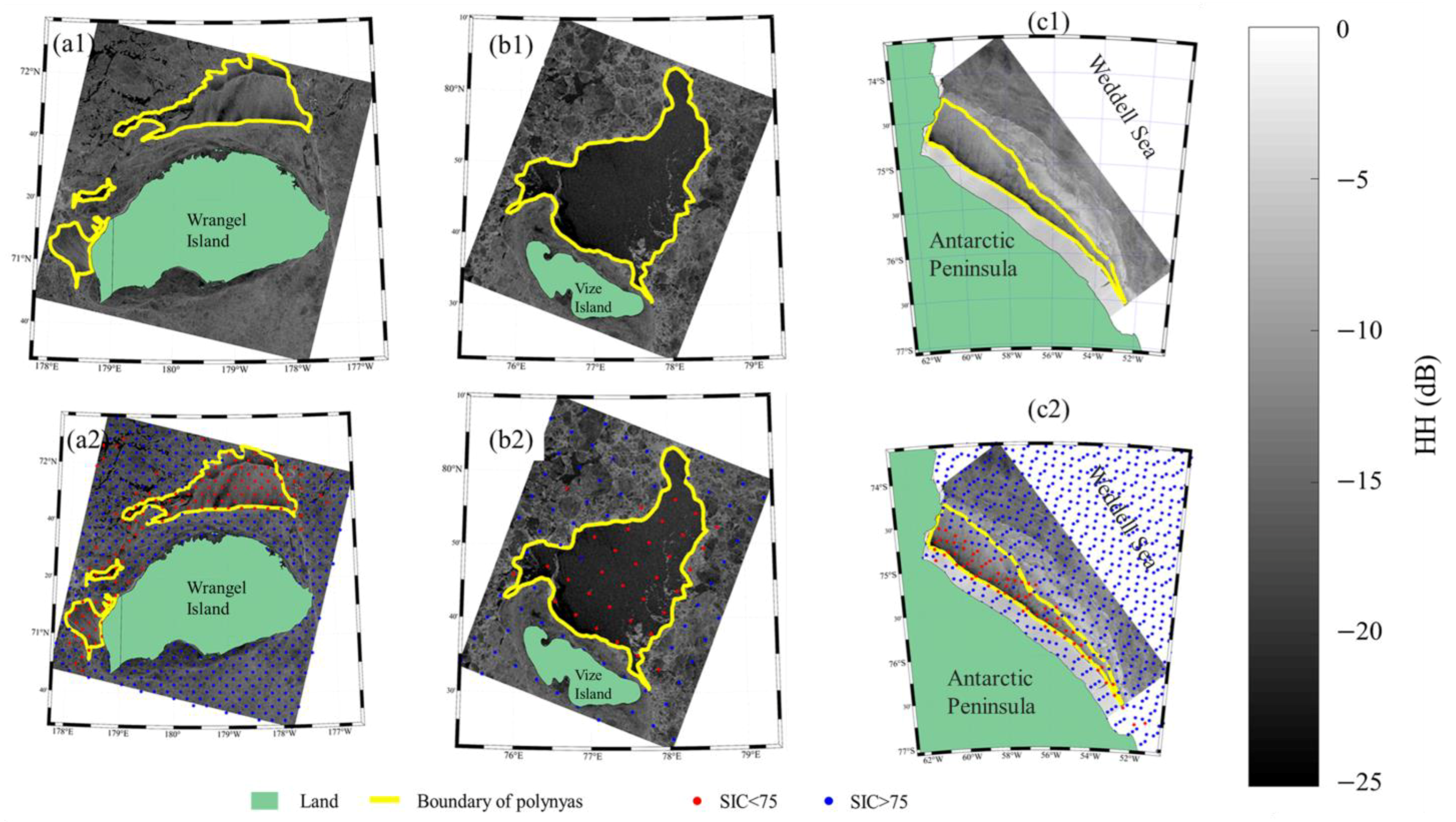


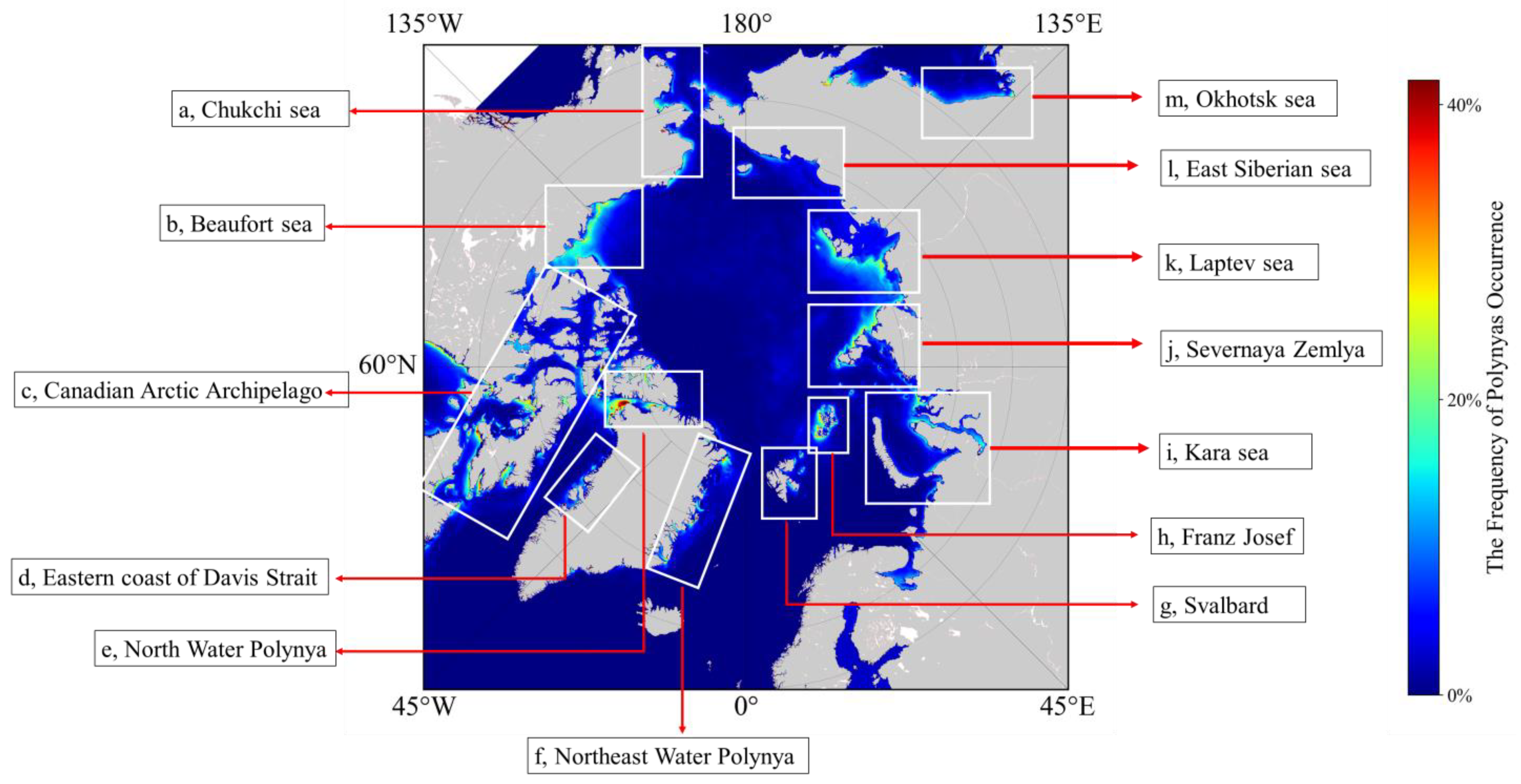
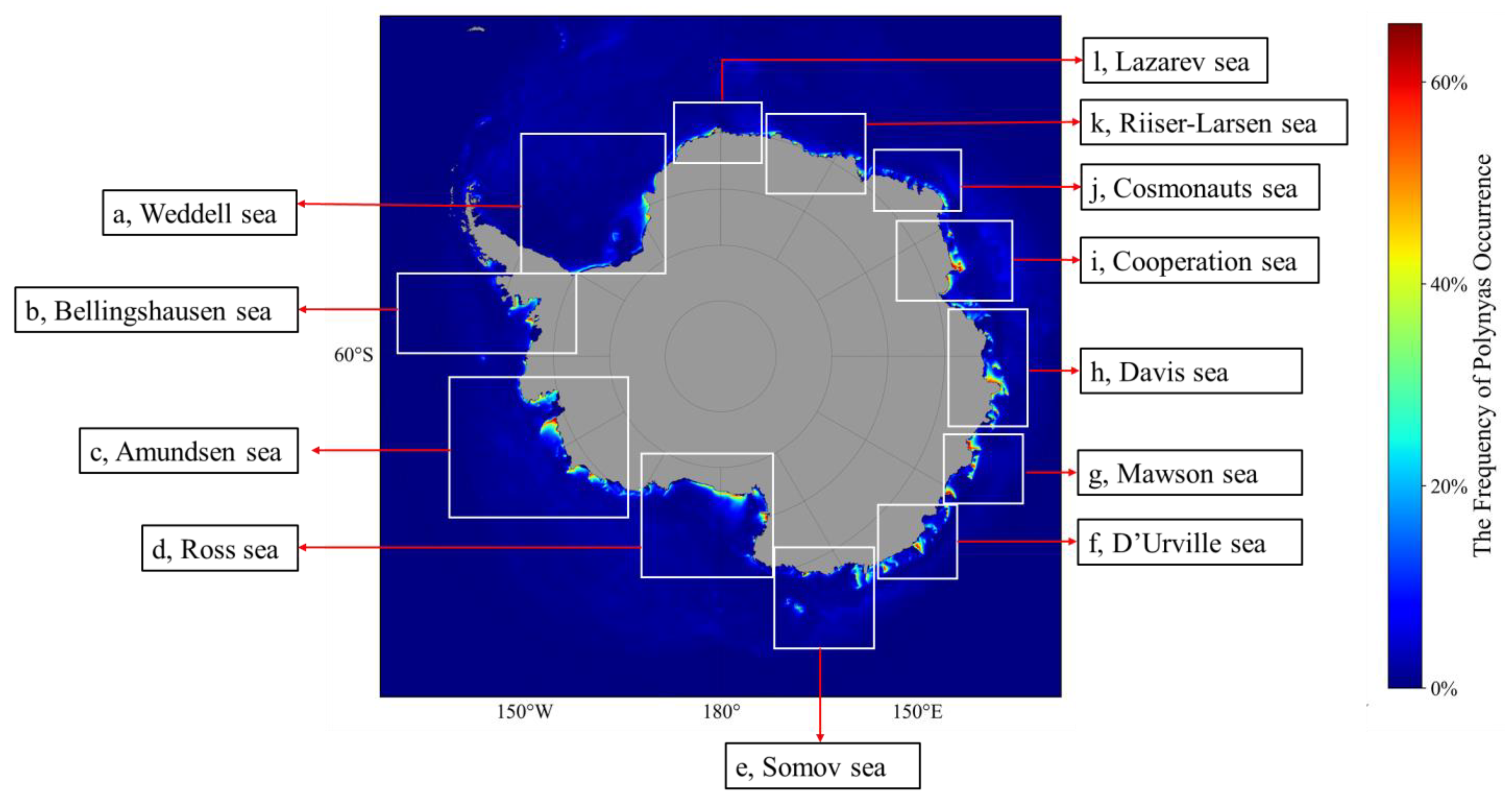

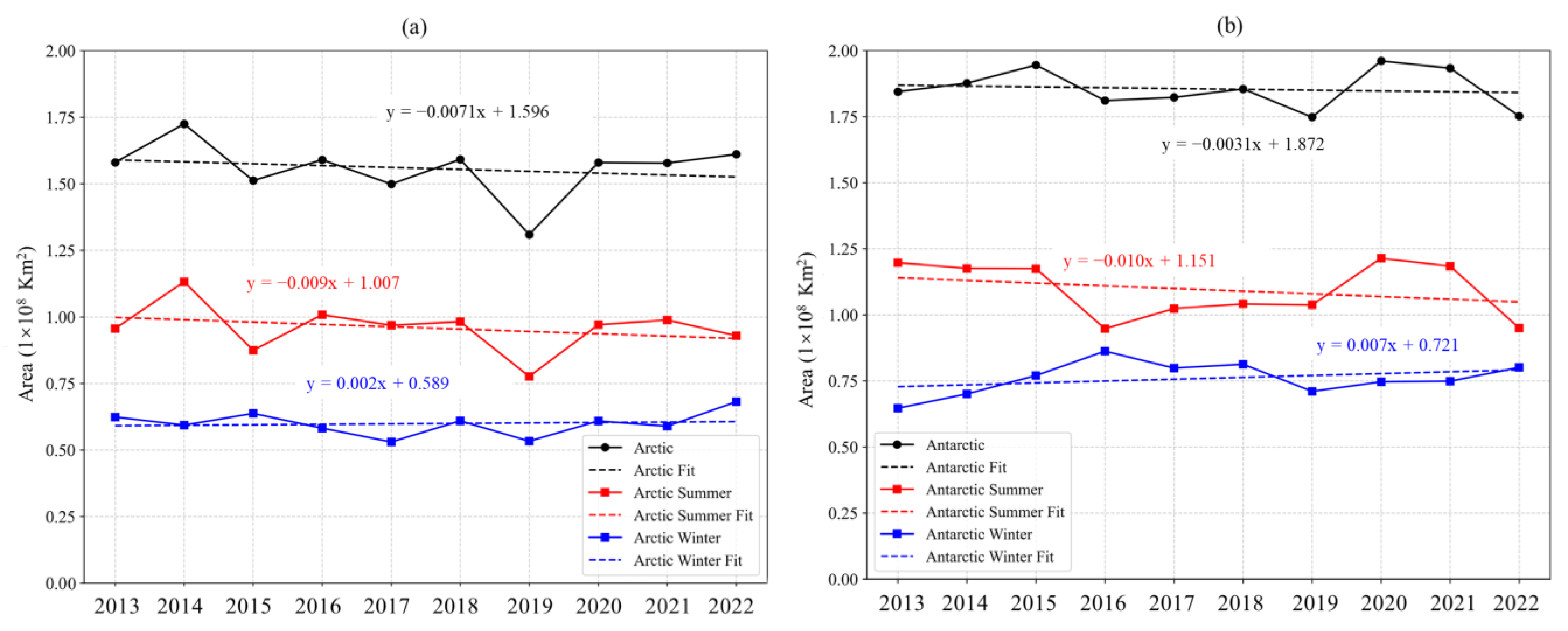
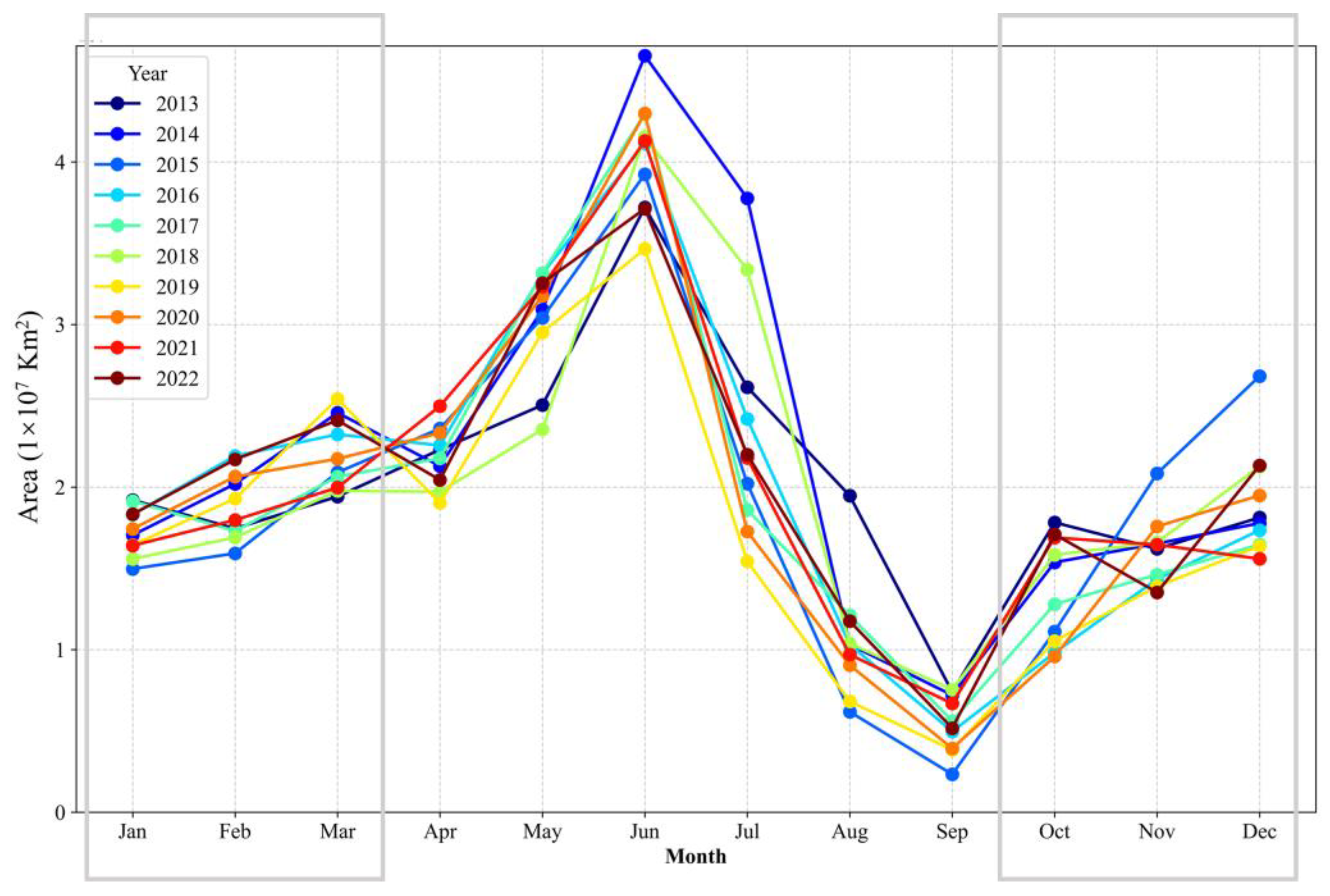
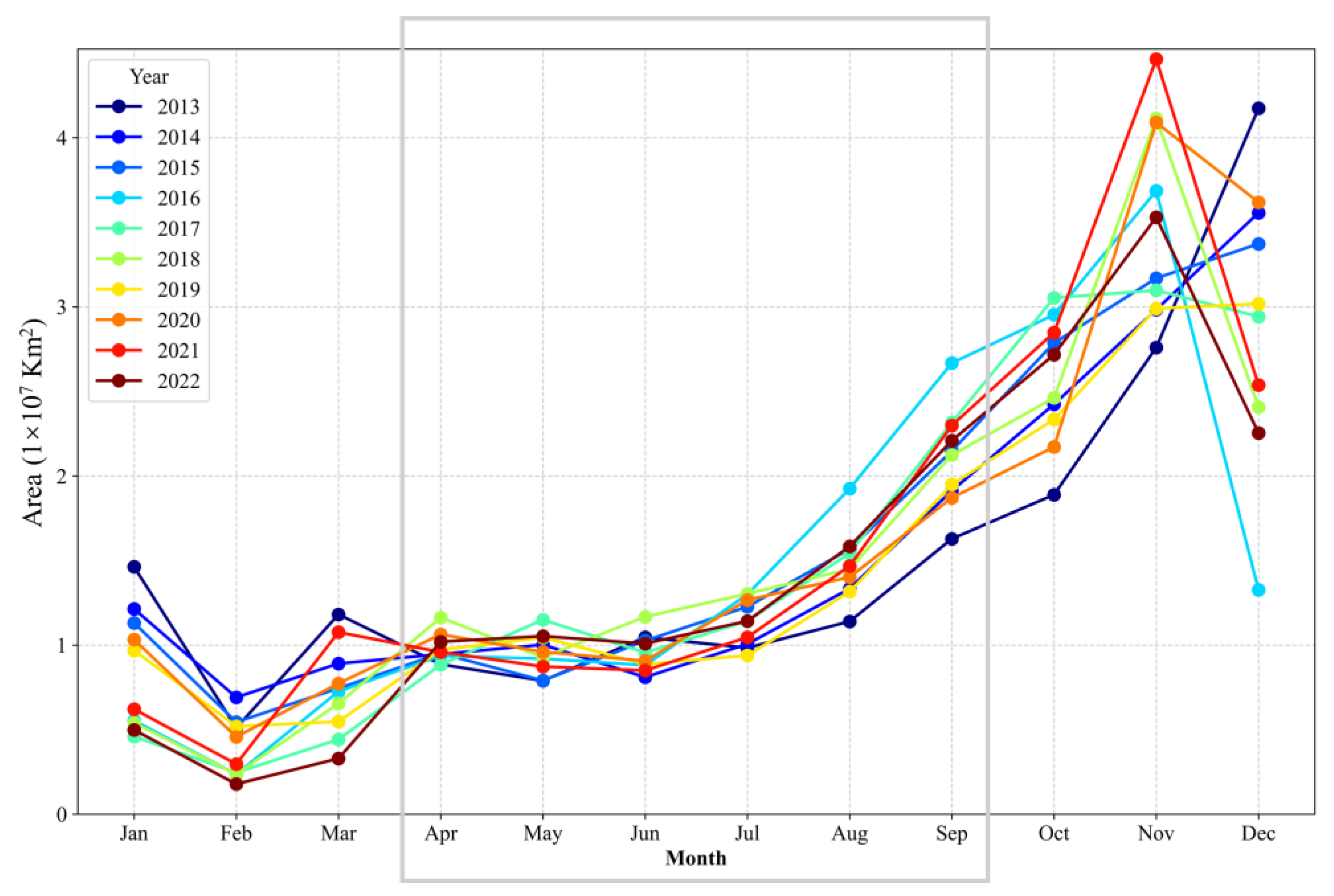


Disclaimer/Publisher’s Note: The statements, opinions and data contained in all publications are solely those of the individual author(s) and contributor(s) and not of MDPI and/or the editor(s). MDPI and/or the editor(s) disclaim responsibility for any injury to people or property resulting from any ideas, methods, instructions or products referred to in the content. |
© 2025 by the authors. Licensee MDPI, Basel, Switzerland. This article is an open access article distributed under the terms and conditions of the Creative Commons Attribution (CC BY) license (https://creativecommons.org/licenses/by/4.0/).
Share and Cite
Yang, K.; Wu, J.; Li, H.; Xu, F.; Zhang, M. Map of Arctic and Antarctic Polynyas 2013–2022 Using Sea Ice Concentration. Remote Sens. 2025, 17, 1213. https://doi.org/10.3390/rs17071213
Yang K, Wu J, Li H, Xu F, Zhang M. Map of Arctic and Antarctic Polynyas 2013–2022 Using Sea Ice Concentration. Remote Sensing. 2025; 17(7):1213. https://doi.org/10.3390/rs17071213
Chicago/Turabian StyleYang, Kun, Jin Wu, Haiyan Li, Fan Xu, and Menghao Zhang. 2025. "Map of Arctic and Antarctic Polynyas 2013–2022 Using Sea Ice Concentration" Remote Sensing 17, no. 7: 1213. https://doi.org/10.3390/rs17071213
APA StyleYang, K., Wu, J., Li, H., Xu, F., & Zhang, M. (2025). Map of Arctic and Antarctic Polynyas 2013–2022 Using Sea Ice Concentration. Remote Sensing, 17(7), 1213. https://doi.org/10.3390/rs17071213




